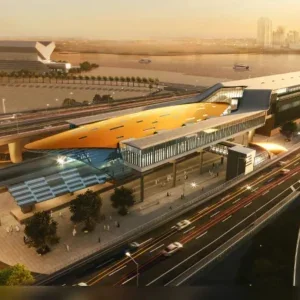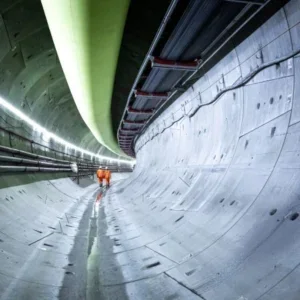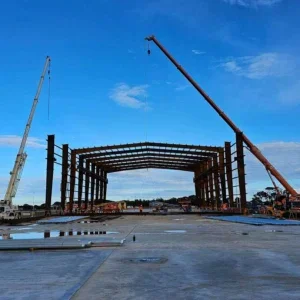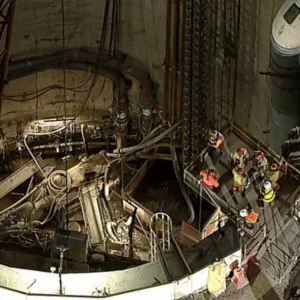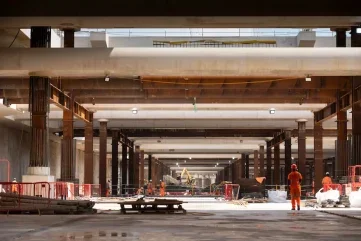
The excavation has taken three years, after permanent construction to form the walls of the box began in June 2021. The vast underground box has a 1.8km-long fibre-reinforced concrete diaphragm wall around it, and 1.3 million tonnes of London clay have been removed.
HS2’s station construction partner, Balfour Beatty Vinci Systra joint venture (BBVS JV), working with specialist structures contractor Expanded, completed the excavation. The project’s 1,500th apprentice, 19-year-old Miguel Jardim, removed the last of the London clay from the box. HS2 says it is on track to meet its target of 2,000 apprenticeships.
The excavation was completed section by section within the box, starting from the west and the east of the structure and meeting in the middle.
The box is 20m deep and a reinforced concrete base slab up to 2m deep is being poured throughout. Some 32,000 tonnes of steel rebar, assembled by hand on site, have been used in the box, alongside 160 reinforced concrete columns which have been installed inside the outer wall to help support the structure.
HS2 says all the steel used was responsibly sourced and most of the concrete is produced by the London Concrete batching plant on site, which reuses rainwater in its mixes. Now the box has been excavated, the team will pour the final sections of base slab to fully complete the box.
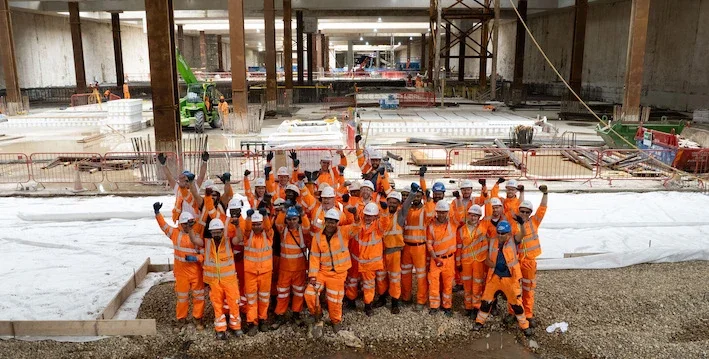
Six 450m platforms will be constructed in the underground box for HS2 services. Above ground, eight further platforms are being built, and will be served by the Elizabeth Line, Great Western Mainline services and the Heathrow Express. Old Oak Common station will become one of the country’s most vital transport hubs, directly connected to more than 170 destinations on the UK’s railway network.
HS2 Ltd’s head of delivery, Sam Clark, said: “The tremendous progress made by our construction team to complete the excavation of the box is an exciting milestone for the project as it signals the next phase of construction where high-speed platforms will be built, as well as the station building itself.”
The excavated London clay has been removed from site by conveyor to the nearby London Logistics Hub, managed by Skanska Costain Strabag (SCS JV). From there it has been transported by rail to reuse sites in Kent, Warwickshire and Cambridgeshire.
Coinciding with the excavation of the box, HS2 has decommissioned the Old Oak Common station conveyor which has removed over 75,000 lorries from the road since November 2022. Further spurs of the conveyor being used for HS2’s tunnelling operation in the area remain in use.
The east end of the underground box has been handed over to HS2’s London Tunnels contractor, SCS JV, which is preparing to construct HS2’s running tunnel to Euston. Two TBMs will be lowered into the underground box later this year, before the station team starts building the station’s roof structure. Timings and funding for the construction of the Euston Tunnel are being confirmed with the government.
When HS2 opens, Old Oak Common will be the temporary terminus in the capital. Plans to transform the wider area around the station, a former railway and industrial site, are being led by the Old Oak and Park Royal Development Corporation. Plans are in place to deliver 25,000 new homes and 56,000 new jobs in the area surrounding the station.
HS2 has also been working with local artists on projects to reuse the London clay. Absolute Beginners, a project for young people led by artist Tom James, is making a dinner service of 100 plates and 100 bowls from some of the excavated materials.



